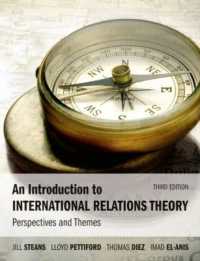- ホーム
- > 洋書
- > 英文書
- > History / World
Full Description
Lapis Lazuli from the Kiln examines the history of the first glass, from its early sporadic occurrence, through the height of its production in the late second millennium BC, to its disappearance at the end of that millennium. The book draws on an exceptionally wide range of sources including ancient texts detailing recipes and trade in glass, iconographic depictions in tombs and temples, archaeological excavation of the most important sites including Amarna and Qantir, and the description of the glass objects themselves. The area covered includes the heart of glassmaking and use in Egypt and the Near East, as well as those areas were glass might have been traded, i.e. the Levant and the Mycenaean Aegean. The life of the glassmaker, his place in society and relationship to other industries are also considered. The book especially details the use of scientific analysis to provide information for the reconstruction of the history of this glass and highlights the importance of analysis in validating or challenging archaeological and textual interpretations. Although describing the most up to date scientific techniques and interpretations, it is written from a non-technical viewpoint and includes systematic glossaries detailing the technical terminology used as well as the most important sites, object types and periods. The book is designed to be a specific study for the student of archaeology demonstrating the general themes of how scientific analysis can assist in the reconstruction of ancient material culture and the society in which it used.
Contents
Table of Contents
List of illustrations
List of color figures
List of tables
1 Introduction
1.1 The structure of glass
1.2 Glassmaking and glass melting
1.3 Glasses and other vitreous materials
2 Introduction to Egypt and the Near East in the Late Bronze Age
2.1 Politics and peoples
2.2 Everyday life
2.3 Crafts and industries
3 The first glass
3.1 Glass before the sixteenth century BC
4 The first regularly produced glass
4.1 Northern Syro-Palestine and Mesopotamia
4.2 Egypt
4.3 Source of the glass
4.4 Towards model for the birth of glassmaking
4.5 After Tuthmosis III - the reign of Amenhotep II
4.6 Analysis and the glass of Tuthmosis III and Amenhotep II
4.7 The first glassmaking workshops
4.8 After Amenhotep II
4.9 Summary of the first glass vessels
5 The Golden Age of glass
5.1 Significant finds of glass
5.2 Nuzi
5.3 Amarna
5.4 Tutankhamen
5.5 Objects of glass in the Late Bronze Age
6 The glass industry and its workshops
6.1 Glassmaking sites
6.2 The organisation of glass workshops
6.3 Qantir
6.4 Other Glass Workshops
6.5 The manufacturing process
6.6 Raw materials
6.7 Technology
6.8 Analysis and the reconstruction of glassmaking
6.9 Glassworking
7 Trade and display
7.1 Value
7.2 Egyptian scenes
7.3 Glass Ingots and Ulu Burun
7.4 Amarna Letters
7.5 Glass in the Levant
7.6 Analysis and the trade in glass
7.7 Aegean and mainland Greece
7.8 Bronze Age Europe
8 The decline in glassmaking
Appendix - Analytical techniques
A.1 Basics
A.2 Scanning Electron Microscope (SEM)
A.3 Microprobe (SEM-WDS)
A.4 Laser Ablation Inductively Coupled Plasma Mass Spectrometry (LA-ICPMS)
A.5 Lead isotope analysis (LIA)
A.6 Strontium isotopic analysis
A.7 Neodymium isotopic analysis
Appendix - Analyses
References
Glossary
Color figures








